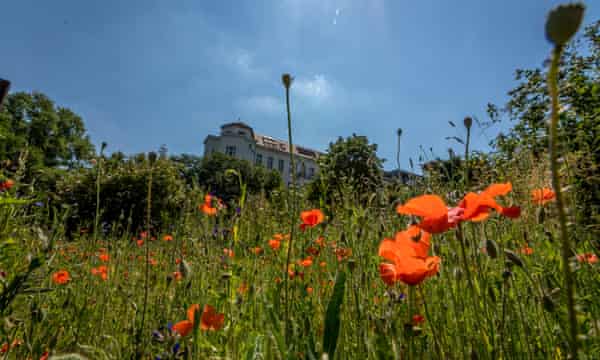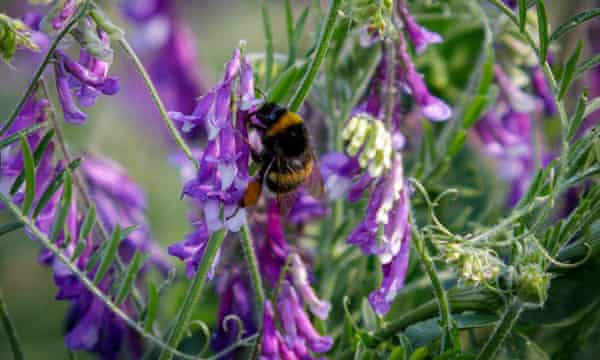To escape the Berlin bustle on a summer afternoon, all that Derek O’Doyle and his dog Frida have to do is lap the noisy building site outside their inner-city apartment, weave their way through the queue in front of the ice-cream van, and squeeze between two gridlocked lorries to cross over Baerwaldstrasse.
Bordered by a one-way traffic system lies a bucolic 1,720 sq metre haven as colourful as a Monet landscape: blue cornflowers, red poppies, white cow parsley and purple field scabious dot a sea of nettles and wild grass as armies of insects buzz through the air. Two endangered carpenter bees, larger than their honey bee cousins and with pitch-black abdomens, gorge themselves on a bush of yellow gorse.
The mini-wilderness on Baerwaldstrasse is one of more than 100 wildflower meadows that have been planted in Germany’s largest cities over the past three years and are coming into full bloom this summer to transform urban landscapes.

Berlin has set aside EUR1.5m to seed and nurture more than 50 wild gardens over a five-year period, while Munich has set up about 30 meadows since 2018. There are similar initiatives in Stuttgart, Leipzig and Braunschweig. Hamburg, which started the trend in 2015, this month unveiled the first of a series of bee-friendly flower beds atop bus shelters.
Juliana Schlaberg of Germany’s Nature and Biodiversity Conservation Union (NABU) said her NGO was receiving more and more requests from city residents who either wanted to grow their own wildflower patches or pressure their council to stop cutting green spaces into manicured lawns.
At first, many of the city meadows met local resistance – from sunbathers, picnickers and especially dog walkers. “I was quite sceptical at first”, said O’Doyle, an Irishman who has lived in the German capital for over a decade. “It looked disorganised. And I resented the loss of a large patch of grass where I could play catch with my dog.”
But the rain-heavy start to this year’s German summer has created a bloom so spectacular that many a doubter has been swayed. The organisers behind the scheme deliberately mixed in endangered flowers that take two years to come into their prime with populist Akzeptanzpflanzen (“acceptance plants”) like poppies and cornflowers, which blossom after only a year. Three years on, the full floral array is on display.
“I’ve changed my mind,” said O’Doyle. “It’s become an incredibly attractive addition to our neighbourhood. You experience the seasons in a whole new way.”
Yet aesthetics are a mere bonus for a scheme with serious purpose: the protection of Germany’s population of wild bees. The country is home to about 580 species of wild bee, of which an estimated 300 can be found in Berlin. More than half are endangered or on the verge of extinction.
A 2017 study by the Entomological Society of Krefeld showed a 75% decline in total flying insect biomass in protected areas in Germany since 1989, with the use of insecticides, exposure to toxic exhaust fumes and above all a loss of diverse habitats cited as reasons for the drastic decline.
The findings inspired a 2019 “save the bees” petition in Bavaria that became the most successful in the southern state’s history, nudging politicians to pass into law its demands without putting them to a referendum first. A similar petition will be handed over to the parliament of the large state of North-Rhine Westphalia in July.
Christian Schmid-Egger, who coordinates Berlin’s wildflower meadows on behalf of the German Wildlife Foundation, said any conservation effort would ultimate require broader changes in agricultural practices: “If we are going to save the bees, we won’t be doing it in cities.”

Nonetheless, he hoped that the urban havens would teach city-dwellers something essential about their natural environment. “Animals need precisely the type of wild natural habitat that humans perceive as a mess that needs to be put in order”, said Schmid-Egger.
Unlike the hive-building honey bee, wild bees are solitary creatures always on the look out for new temporary accommodation, setting up their homes in a variety of habitats that the newly set-up meadows try to provide: carpenter bees nest in dead wood, mining bees dig holes in the soil, and masonry bees burrow into the mortar joints in brick walls.
Others have picky dietary requirements: one Berlin species of mason bee, osmia adunca, only collects pollen off viper’s bugloss, a type of plant that only grows in dry grasslands and waste spaces.
At best, said Schmid-Egger, Germany’s new wildflower meadows could teach urban dwellers the value of unkempt spaces and encourage them to create natural habitats in their own gardens, courtyards or balconies. “Eventually, many such hotspots could create a network of wilderness right inside our cities.”